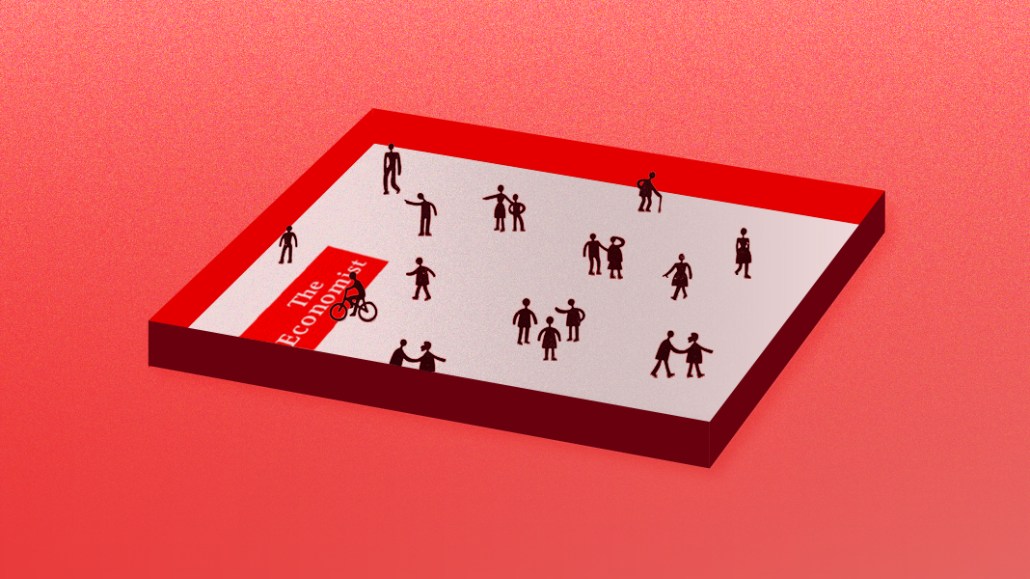Save 50% on a 3-month Digiday+ membership. Ends Dec 5.
To double circulation profits, The Economist has 16 people focused on retention

When ad revenue growth was strong, publishers could justify pumping up circulation numbers willy-nilly. With those days over, publishers like The Economist are turning their attention to retention.
The Economist has set a goal of doubling its circulation profits by 2020. To do that, it needs to grow digital subscriptions, which number about 350,000 out of a total circulation of 1.5 million, and keep subscribers from canceling because replacing canceled subscribers is expensive. At the head of this effort is Anna Rawling, evp of customer experience and product strategy for The Economist.
“The journey started about three years ago,” Rawling said. “We became more focused on circulation and driving subscriptions with an overriding focus on profitability rather than volume. Prior to that, we had profitability targets, but it was more of a volume play to support advertising.”
Rawling has 32 people who report to her, and half of them focus on retention. Once people have subscribed to The Economist for a year, they tend to retain well. But a lot has to happen in between. Their work focuses on nitty-gritty things like the right number of times to contact subscribers when they’re at risk of canceling (four if they’re set up to auto-renew their subscription with a credit card and 12 if they’re not on auto-renew) and figuring out how frequently people need to read to keep them renewing.
With the focus on retention, The Economist has moved its attention to the latter question. Addressing that starts with improving the experience people have the moment they subscribe. Now, new subscribers will get a welcome email from the editor and a video about The Economist. It’s also promoting its main mobile app more heavily, since app users tend to stick better. Rawling wouldn’t share numbers but said that in a test, those that got the welcome material showed a single-digit improvement in retention over the people that just got the dry, functional experience.
The increased focus on subscriber revenue is also forcing previously separate departments to collaborate. At The Economist, Rawling has created three cross-functional “tribes” to work on app, website and newsletter projects. These teams have a combination of editorial, product, marketing, analytics and design experts. They’re working on redesigning the app so people use it more regularly. One proposed change would consolidate all The Economist’s journalism in the app, which is updated weekly, so people wouldn’t have to worry about missing something that ran on the website or on The Economist’s Espresso, an app that’s updated daily.
Along with the mobile app, The Economist is trying to make its daily and weekly newsletters work harder to retain subscribers. The Economist is in a good position in that it has passionate readers. Getting them to form a regular reading habit is the trick, though. The Economist is exploring how it can use its newsletters to prompt people to read the edition when it comes out every Thursday as well as nudge them to read it on the weekend, when they have more time.
Ad position: web_incontent_pos1
“We know The Economist is a lot to read,” Rawling said. “We know that is a barrier to retention.”
More in Media

Digiday+ Research Subscription Index 2025: Subscription strategies from Bloomberg, The New York Times, Vox and others
Digiday’s third annual Subscription Index examines and measures publishers’ subscription strategies to identify common approaches and key tactics among Bloomberg, The New York Times, Vox and others.

From lawsuits to lobbying: How publishers are fighting AI
We may be closing out 2025, but publishers aren’t retreating from the battle of AI search — some are escalating it, and they expect the fight to stretch deep into 2026.

Media Briefing: Publishers turn to vertical video to compete with creators and grow ad revenue in 2026
Publishers add vertical video feeds to their sites to boost engagement, attract video ad spend and compete with news creators.
Ad position: web_bfu



